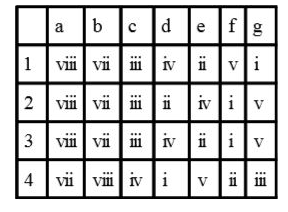The correct centripetal sequence of different parts of cilium or flagellum
A. Central sheath B. Central microtubule C. Radial spoke D. Plasmamembrane E. Peripheral microtubules
D,E,C,B,A
D,E,A,C,B
D,B,C,A,E
D,E,C,A,B
The correct Answer is:D
To determine the correct centripetal sequence of different parts of a cilium or flagellum, we can follow these steps:
1. Identify the Structure: Understand that cilia and flagella have a specific arrangement of microtubules and associated structures. They are typically organized in a "9+2" arrangement, which means there are 9 pairs of peripheral microtubules surrounding 2 central microtubules.
2. List the Components: The components provided in the question are:
- A. Central sheath
- B. Central microtubule
- C. Radial spoke
- D. Plasma membrane
- E. Peripheral microtubules
3. Determine the Outermost Layer: The plasma membrane (D) is the outermost layer of the cilium or flagellum. Therefore, it comes first in the sequence.
4. Identify the Peripheral Microtubules: Next, the peripheral microtubules (E) are located just beneath the plasma membrane. They form the outer ring of the structure.
5. Locate the Radial Spokes: The radial spokes (C) extend from the peripheral microtubules towards the central sheath and central microtubules. They are positioned after the peripheral microtubules in the sequence.
6. Central Sheath Position: The central sheath (A) surrounds the central microtubules and comes next in the sequence.
7. Central Microtubules: Finally, the central microtubules (B) are at the center of the arrangement and are the innermost part.
Final Sequence:
Based on the arrangement, the correct centripetal sequence is:
1. D. Plasma membrane
2. E. Peripheral microtubules
3. C. Radial spoke
4. A. Central sheath
5. B. Central microtubule
Thus, the correct answer is D, E, C, A, B.
- A. Central sheath
- B. Central microtubule
- C. Radial spoke
- D. Plasma membrane
- E. Peripheral microtubules
Based on the arrangement, the correct centripetal sequence is:
1. D. Plasma membrane
2. E. Peripheral microtubules
3. C. Radial spoke
4. A. Central sheath
5. B. Central microtubule
Similar Questions
In the axoneme of cilium, the pair of central microtubules are connected to peripheral to peripheral microtubules (doublet) by
View SolutionThe core of a cilium or flagellum composed of microtubules and their associated proteins is called
View SolutionAssertion : The arrangement of axonemal microtubules in cilia or flagella is called 9 + 2 array.
Reason : The axoneme usually has nine pairs or doubles of radially arranged peripheral microtubules, and a pair of centrally located microtubules.
View Solution
Identify a, b, c, d, e, f and g from the given words:-
(i) Interdoublet bridge
(ii) Central microtubule
(iii)Radial spoke
(iv) Plasma membrane
(v) Peripheral microtubule
(vi) Cell wall
(vii) Central bridge
(viii) Central sheath

View SolutionThe arrangement of central and outer microtubules in the cilium is
View SolutionRead the following statements and find out the correct statements. a. Prokaryotic and eukaryotic flagella are structurally similar b. Cilia work like oars and comparatively smaller than flagella c. The core of cilium or flagellum is called axoneme d. Central tubules are connected by interdoublet bridges and is enclosed by central sheath e. Central sheath is connected to one of the tubules of each peripheral doublets by a radial spoke. There are nine radial spokes f. Peripheral doublets are also interconnected by linkers
View Solution
Identify a, b, c, d, e, f and g from the given words:-
(i) Interdoublet bridge
(ii) Central microtubule
(iii)Radial spoke
(iv) Plasma membrane
(v) Peripheral microtubule
(vi) Cell wall
(vii) Central bridge
(viii) Central sheath

View SolutionThe core of a cilium or flagellum composed of microtubules and their associated proteins is called
View Solution

